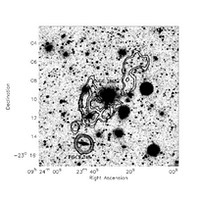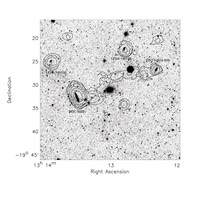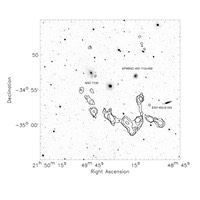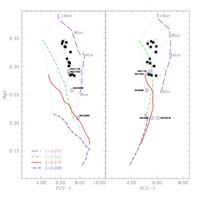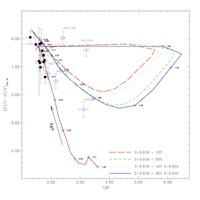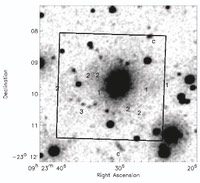NGC 2865. The GALEX NUV image has been smoothed with an adaptive filter to enhance the outer fine structures. We labeled the NE and NW protrusions (1) and the shell system (2) visible in the HST-ACS field of view (see also Fort et al. 86). We further labeled with 3 a chain of possibly background galaxies barely visible in the optical band and with c the galaxies indicated as companions by Fort et al. The box inthe NUV and FUV images marks the HST-ACS FOV.
Using Fabry-Perot observations, Rampazzo (2003) analyzed the warm gas kinematics in a few shell galaxies. They found that gas and stars appear to be decoupled in most cases. This evidence suggests an external acquisition of the gas, as predicted by merging models. At the same time, a set of observations showing a clear association between cold (HI/CO) gas and stars challenge present merging models which do not predict it unless cold gas behaves differently from the ionized gas (Schiminovich et al. 1994; Schiminovich et al. 1995; Charmandaris et al. 2000; Balcells et al. 2001). Studying the distribution of shell galaxies in the Hb vs [MgFe] line-strength index plane, Longhetti (2000) show that these systems span a wide range of ages, indicating that among them recent and old interaction/acquisition events are equaly probable. If shells are formed at the same time at which the rejuvenating event took place, shells ought to be long-lasting phenomena. So, whereas current studies in literature consider the shell structure surrounding early-type galaxies as a bona fide indicator of past accretion/merging events, their formation age and secular evolution are far from being firmly established. In the above framework we start a GALEX project through which we aim to verify whether these galaxies host ongoing star formation and, if any, how it distributes across the galaxy.
We present here a pilot study concerning GALEX observations of three shell galaxies taken from the Malin & Carter (1983) compilation, namely NGC 2865, NGC 5018 and NGC 7135. The galaxies are located in very low density environments and belong to HI rich associations. NGC 2865 and NGC 7135 are part of our GALEX proposal (GI04-0030-0059). The NGC 5018 data are taken from the GALEX archive. The line-strength indices analysis performed by Longhetti et al. (2000) and Annibali et al. (2007) suggests that the above shell galaxies had a recent burst of star formation.
The NUV emission of NGC 7135 and NGC 2685 mirrors the optical appearance and features. This implies that the UV emission comes from the same kind of stellar populations. The FUV images are instead more concentrated toward the nucleus in the case of NGC 2865 and/or in the case of NGC 7135 other particular regions of the galaxy thus suggesting that different types of hot stars contribute to the flux. In the case of NGC 5018, for which only the NUV image is available, it is not possible to reveal the shell structure visible in the optical, whereas the presence of a complex dust-lane system is seen.
All the galaxies show evidence of dust features in their centre. This confirms the trend found by Sikkema (2007) who suggest that the dust detection rate in the shell ellipticals is significantly higher than in a normal elliptical sample. Furthermore the irregular shape of shell galaxies suggests that external influences and/or acquisition of material are the cause of the dust features.
The three galaxies seem to belong to loose, poor groups rich of cold gas whose presence is traced by the HI emission. We suggest that these objects typically occur in evolving groups similar to the Arp 227 group dominated by the shell galaxy NGC 474 (Rampazzo 2006). No galaxy of our sample shows the presence of cold
gas in its innermost regions. In the case NGC 2865 Schiminovich (1995) find that the outer cold gas is kinematically associated to the stellar body. This strongly suggests that whatever the phenomenon giving rise to the shells might be (the agreement between the gas and stellar kinematics somewhat rejects the merging
hypothesis) it is able to convert the gas in the central regions into stars, thus rejuvenating the galaxy in agreement with what inferred from the line--strength indices.
The analysis of the colour evolution of single and composite stellar populations simulating past and/or recent star formation shows that (i) the colour (FUV-NUV) has good sensibility to metallicity and age over a long fraction of a galaxy life; (ii) The colour (NUV-V) soon becomes nearly age independent, say 2 - 3 Gyr past the star forming activity both after the initial episode and the burst. This time interval increases with the fractionary mass engaged in the star forming episode. So it is rather long in the initial episode (up to 4 Gyr) and only 1-2 Gyr after a burst of moderate intensity. It runs nearly flat during the long time interval between the two star forming episodes (in this simulation). It keeps, however, some dependence on the metallicity shifting to higher values at increasing Z; (iii) finally, the colour (FUV-V) keeps a good dependence on both age and metallicity all over the galaxy life. In the typical case of secondary activity of moderate intensity, all the colours but for (FUV-NUV) and (FUV-V), become nearly age insensitive when 1-2 Gyr have elapsed from the last star forming episode Jeong et al. (2007).
Most likely, the NUV and FUV fluxes of normal early-type galaxies have different origins. Independently of its extension across a galaxy, the NUV flux is partially due to the MS turnoff stars of the evolved population (Dorman 2003) and partially to more evolved, exotic stars. In contrast, a strong FUV emission is likely due to the presence of one (or more) hot, plausibly high-metallicity, stellar components giving origin to the well-known phenomenon of the UV-upturn (e.g. hot-HB and/or post-AGB and AGB manqu\'e stars). Further complication comes from the analysis of the optical indices, which suggest that the three shell galaxies in our study had a recent (2-3 Gyr old) burst of stellar activity, possibly as a consequence of the interaction/accretion episode that triggered the shell formation. In this context, it comes naturally that the stellar populations should
span a certain range of ages and also that young stars could be present in different proportions in both the NUV and FUV fluxes. All this makes the interpretation of the data more difficult.
Our combined analysis of the (FUV-NUV) and (UV-V) colours and line--strength indices shows that even simple models such as SSPs mimicking the passive evolution of a galaxy can account for most of the gross features of shell galaxies as well as those of normal early-type galaxies. Among the shell galaxies in the sample, the nucleus of NGC~7135 shows the more peculiar behavior when compared with theoretical expectation of passive evolution. Considering composite stellar population models with a recent burst of star formation, we show that the position of the NGC~7135 nucleus in the (FUV-NUV)-Hb plane could be explained in term of a recent rejuvenation episode. NGC~2865 and the other few shell galaxies, which have a nearly normal position in the above plane, could also fit the same rejuvenation framework.
Recently van Dokkum (2005) suggests that dry mergers, i.e. nearly dissipationless, or gasless mergers, at low redshift are responsible for much of the local bright field
elliptical galaxy population. Donovan et al. (2007) demonstrated that the morphological and photometric criteria adopted by van Dokkum (2005) to identify dry merger candidate could include early-type galaxies with HI in or around them i.e. possible wet ellipticals. The sample they considered is taken from the HI Rogues Gallery Hibbard et al. (2001) and include NGC 2865, NGC 5018 and NGC 7135 which all fit the criteria for being dry mergers candidate. Our results suggest that the merger that has induced a secular evolution in NGC~7135 (and possibly in NGC 2865) should not have been so dry.
more details in Rampazzo R., Marino A., Tantalo R., Bettoni D., Buson L.M., Chiosi C., Galletta G., Grutzbauch R., Rich R.M.
The Galaxy Evolution Explorer UV emission in shell galaxies: tracing galaxy `rejuvenation' episodes
2007, MNRAS, 381, 245
